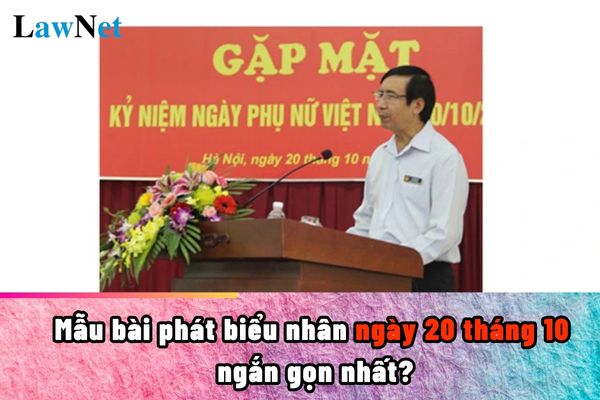What are sample script for hosting a program celebrating October 20 in Vietnam? What are regulations on evaluation of students' training results in Vietnam?
What are sample script for hosting a program celebrating October 20 in Vietnam?
The script for hosting a program celebrating October 20 is an essential part of organizing the annual Vietnamese Women's Day celebration on October 20th at schools or other venues.
|
Sample script for hosting a program celebrating October 20 General Procedures for the Program MC1: Kính thưa quý vị đại biểu, quý thầy cô, các bạn học sinh thân mến! MC2: Hôm nay, chúng ta cùng nhau tề tựu tại đây để kỷ niệm một ngày đặc biệt - Ngày Phụ nữ Việt Nam 20/10. Both: Một ngày để chúng ta bày tỏ lòng biết ơn và kính trọng đối với những người phụ nữ tuyệt vời! MC1: Kính thưa quý vị đại biểu, quý thầy cô, các bạn học sinh thân mến! Hôm nay, chúng ta cùng nhau tề tựu tại đây để kỷ niệm một ngày đặc biệt - Ngày Phụ nữ Việt Nam 20/10. Một ngày để chúng ta bày tỏ lòng biết ơn và kính trọng đối với những người phụ nữ tuyệt vời! MC2: Xin được gửi lời chào trân trọng nhất và lời chúc sức khỏe, hạnh phúc tới tất cả quý vị có mặt trong ngày hôm nay. MC1: Để mở đầu cho chương trình, xin mời tất cả cùng lắng nghe bài hát "____" do câu lạc bộ ca hát của trường biểu diễn. (Song suitable for a joyful, energetic atmosphere) Opening Speech: Representative of the Organizing Committee |
*Note: Information is for reference only./.

What are sample script for hosting a program celebrating October 20 in Vietnam? What are regulations on evaluation of students' training results in Vietnam? (Image from the Internet)
What are regulations on evaluation of lower secondary school students' training results in Vietnam?
Based on Clause 1, Article 8 of Circular 22/2021/TT-BGDDT, the evaluation of lower secondary school students' training results is regulated as follows:
Evaluation of Students' Training Results
1. Basis and organization of evaluating students' training results
a) The evaluation of students' training results is based on the requirements to achieve primary qualities and general competencies at appropriate levels with the subject, educational level as stipulated in the Overall Program and specific competency requirements in the Subject Program of the General Education Program.
b) Subject teachers, based on the provisions at point a of this clause, comment, evaluate the students' training results, progress, prominent advantages, and main limitations during the subject's training and learning process.
c) Homeroom teachers, based on the provisions at point a of this clause, monitor students' training and learning process; refer to comments, evaluations of subject teachers, feedback from students' parents, relevant agencies, organizations, and individuals involved in students' education; guide students to self-assess; based on that, comment and evaluate students' training results according to the levels regulated in clause 2 of this Article.
...
The homeroom teacher, based on the provisions at point a of Clause 1, Article 8 of Circular 22/2021/TT-BGDDT, monitors the training and learning process of students; refers to comments, evaluations of subject teachers, feedback from students' parents, and relevant agencies, organizations, and individuals involved in student education;
Teachers guides students in self-assessment; based on that, comments and evaluates students' training results according to the levels regulated in clause 2, Article 8 of Circular 22/2021/TT-BGDDT.
Thus, according to the regulations, the homeroom teacher will base the evaluation on the requirements to achieve primary qualities and general competencies at levels appropriate to the subject, educational level as specified in the Overall Program and the specific competency requirements in the Subject Program of the General Education Program to evaluate the training results of lower secondary school students.
What are the responsibilities of teachers in evaluating lower secondary school students' training Rwsults?
As per Clause 6, Article 20 of Circular 22/2021/TT-BGDDT, the responsibilities of homeroom teachers in lower secondary schools are stipulated as follows:
Responsibilities of the Homeroom Teacher
1. Assist the Principal in managing the evaluation of students in the class according to the regulations of this Circular.
2. Confirm the correction of marks, adjustment of evaluation levels by subject teachers; summarize training and learning results of students each semester, the whole school year in the Student Monitoring and Evaluation Record (per class), Student Report Card.
3. Evaluate training results each semester and the whole school year of students; prepare a list of students being promoted, assessed again in subjects and training during summer vacation, not being promoted, being commendated.
4. Record or input the evaluation results of each student into the Student Monitoring and Evaluation Record (per class), Student Report Card:
a) Comments on training and learning results of students; evaluation levels of training and learning results of students.
b) Results of being promoted or not; recognized completion of lower secondary school program, high school program or not; commendation.
5. Guide students to self-assess during the training and learning process. Coordinate with subject teachers, the Ho Chi Minh Young Pioneer Organization, the Ho Chi Minh Communist Youth Union, the Class Parent Committee, and relevant agencies, organizations, individuals to educate students and receive feedback on students' training and learning process.
6. Notify parents of the training and learning process, outcomes of their children.
According to the regulations, assessing lower secondary school students is the responsibility of the homeroom teacher. The homeroom teacher will perform the following tasks:
- Summarize training and learning results of students each semester, the whole school year in the Student Monitoring and Evaluation Record (per class), Student Report Card.
- Record or input the evaluation results of each student into the Student Monitoring and Evaluation Record (per class), Student Report Card:
+ Comments on training and learning results of students; evaluation levels of training and learning results of students.
+ Results of being promoted or not; recognized completion of the lower secondary school program or not; commendation.
Thus, once the homeroom teacher completes evaluating lower secondary school students' training results, they must have the responsibility to send individual notifications to parents about the process and outcomes of the students' training and learning.










- Sample essay on describing trees for Grade 4 in a concise manner? Which subject is a compulsory subject in the Grade 4 curriculum?
- What is a STEM Career? What is the subject whose curriculum covers STEM careers in Vietnam?
- Vietnam: What is the sample outline of an essay on the analysis of expressions of national spirit in the Poem "Việt Bắc" for 12th-grade students? What patriotic qualities are required for 12th-grade students?
- Vietnam: What are your thoughts on the Poem "Tiếng ru" by To Huu? How many lessons are there in the 12th-grade Literature curriculum per year?
- What are the sample essays describing your grandfather for 5th-grade students in Vietnam? What are the assessment criteria for 5th-grade students in 2024?
- Vietnam: What are the sample social argumentative essays on social media etiquette for 10th-grade students? What Vietnamese knowledge do 10th-grade students learn?
- Vietnam: Why is the French Bourgeois Revolution considered the most thorough one? What learning outcomes are required for 11th-grade students after studying the bourgeois revolution?
- Vietnam: What is the atmosphere? What is the grade at which students are required to master the knowledge of the atmosphere in the History and Geography curriculum?
- Vietnam: Why does the phenomenon of day and night alternation occur on Earth? What is the grade at which students learn about the phenomenon of day and night alternation on Earth?
- What is the newest report template on distance education at the higher education level in Vietnam?

